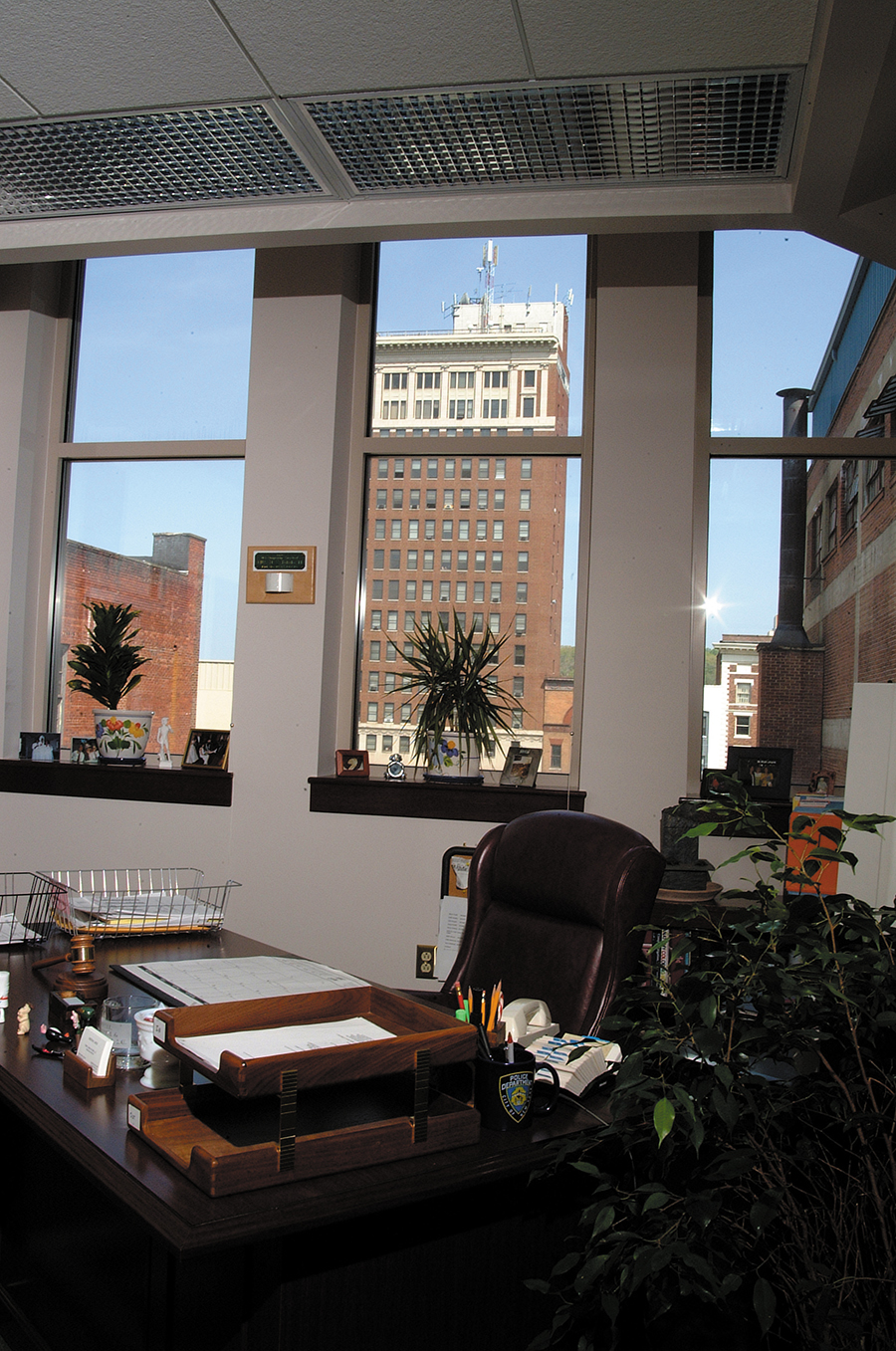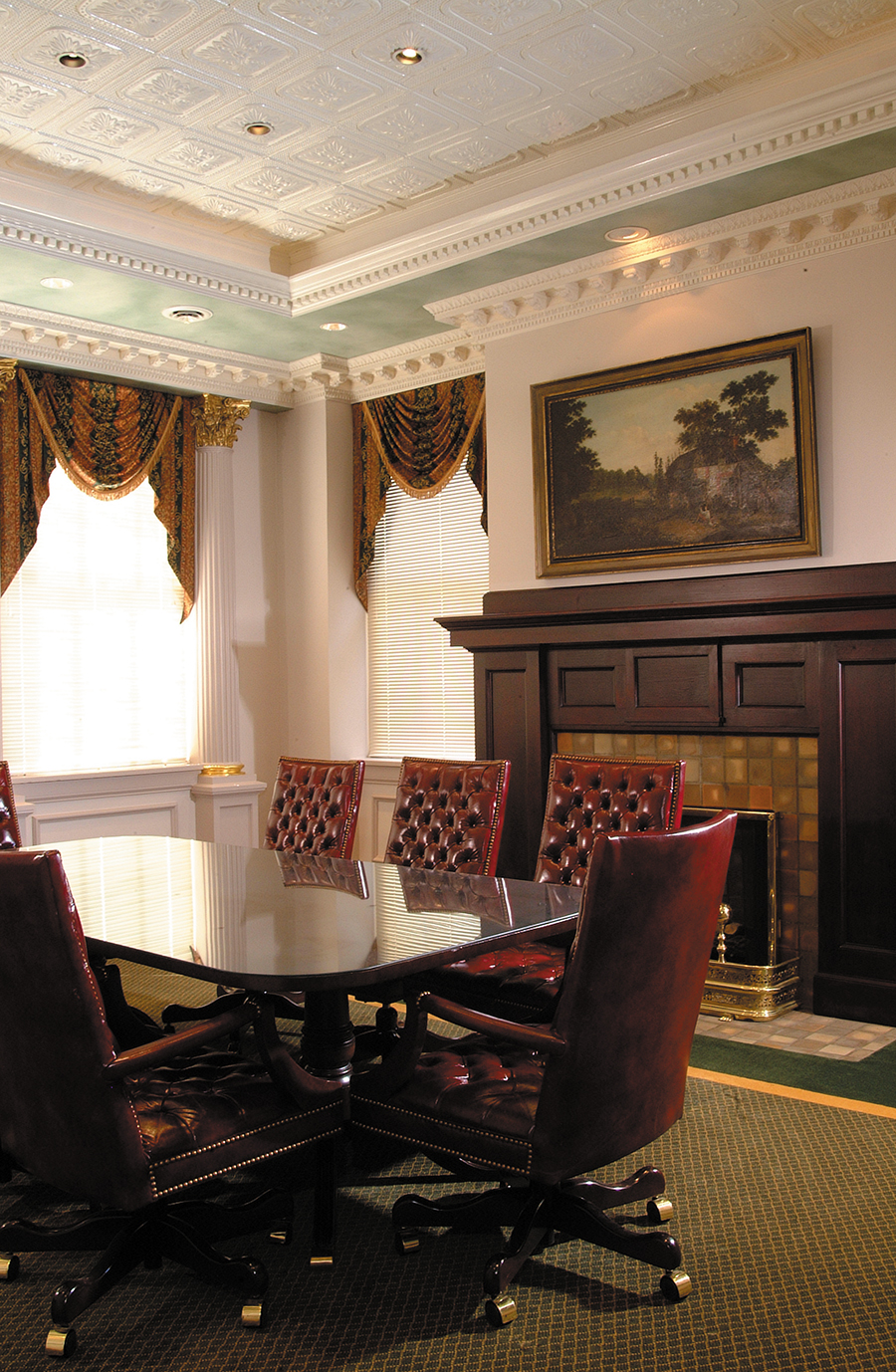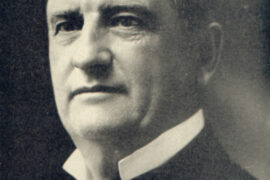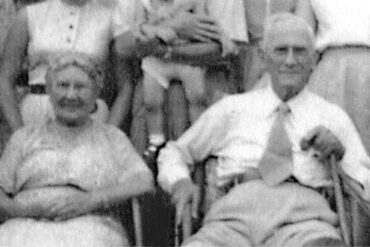By Benita Heath
HQ 42 | SUMMER/AUTUMN 2001
Next to the old Carnegie Library on Fifth Avenue between Ninth and 10th Streets, the former Switzer Building stands like an impenetrable fortress, stately and formidable in its granite facade. For at least 30 years, Huntington attorney and renowned renovator John Hankins has been captivated by this architectural grande dame of Huntington.
But wait a minute. All that glitters is not gold … or rather granite.
Does the redoubtable Switzer Building have feet of you know what? That granite front you see isn’t granite at all, but rather the soft pliable stuff every grade school kid loves to get his hands in.
That’s right — clay. Architectural experts like Hankins will call it terra cotta. But it’s still clay and what the designers of the Switzer Building did with it is amazing.
“Most terra cotta that you see is yellow-ivory in color. If you look at the Reuschlein building, it’s a prime example of terra cotta,” Hankins said. “But the Switzer Building does a departure. They made theirs look like granite. From 10 feet away, you’d think it was granite. They were trying to give the illusion of the stability of granite. But take a hammer to it and it would break into pieces.”
Terra cotta had its architectural heyday from around the turn of the century to the 1930s, says Todd McClavey, vice president of Superior Clay Corp., a manufacturer of architectural terra cotta and components for masonry fireplaces in Uhrichsville, Ohio, just outside Canton.
“It got its start after the Chicago fire,” McClavey said. “People wanted something that was fireproof. Architects like Louis Sullivan liked to use it.”
Their reason for choosing it was the adaptability of the material and basic economics. Working with terra cotta was a lot cheaper than chiseling designs into hard stone.
Simply, terra cotta, which gets its name from the Latin for baked earth, is fired clay.
Just as the facade of the Switzer isn’t what it appears, the name is a fooler too. Rufus Switzer, a highly-respected civic leader, city mayor and father of Huntington’s park system, didn’t build the structure that for decades honored his name and legacy.
Today, just above the archway in letters too high for a passerby to see easily are the words “HeraldDispatch,” marked in the clay facade. That’s because for a short time the Switzer Building was the home of what is now Huntington’s daily newspaper. And the current H-D building on the corner of Fifth Avenue and 10th Street was the original headquarters for its competitor — The Advertiser. Needless to say, the two papers became involved in an epic conflict.
The year was 1927, and the streets of Huntington were a battlefield. The two combatants, however, fought with ink and paper rather than with bombs and bullets. This was a newspaper war, the likes of which the city had never witnessed before and would never see again.
At the helm of The Advertiser was Col. Joseph Harvey Long. Long was a Pennsylvania native of German ancestry whose first forays into the publishing realm were in Ohio and northern West Virginia. Early on he proved himself an innovator when he and a partner bought what they christened the Wheeling News. There the two youthful entrepreneurs introduced the first Linotype operation to the state.
When Long heard about a paper for sale in Huntington, he sold his interest in the Wheeling paper to his partner and moved south to buy the Huntington Herald. However, the honeymoon with that paper was short-lived. ln two years Long sold the Herald, but liked his new hometown so much he decided to buy the competition.
In 1895 he bought The Advertiser where for decades he brought innovations to the daily, the hallmark being a model facility built at the corner of Fifth Avenue and 10th Street in 1926, a building that remains in use today. The Advertiser, an afternoon paper, was fiercely Democratic.
The Herald-Dispatch, a morning publication equally fixed in its Republican views, was owned by Dave Gideon, son of civic leader Sam Gideon.
And so in the 1920s it was inevitable the two men and two papers would lock horns.
The Advertiser’s new building was the talk of the town. And so, not to be outdone, Gideon also built a new home for The Herald-Dispatch next to the old Cabell County Library.
“This was an obvious attempt of (Herald-Dispatch publisher) David Gideon to keep up with the Longs and for them to view him as their competitor,” Hankins said.
There’s disagreement about who fired the first shot in Huntington’s Great Newspaper War. Certainly it seems hardly coincidental that the fanfare which marked the opening of the new home of The HeraldDispatch had died down before The Advertiser announced it was slashing its subscription rate from 15 cents a week to 10 cents.
The Herald-Dispatch not only responded by cutting its own rate but also introduced a new afternoon paper, The Evening Journal, clearly aimed at winning reads away from The Advertiser.

The battle raged for months and might have gone on longer, but unbeknownst to those in the trenches peace negotiations were going on behind the scenes. On Aug. 8, 1927, the rival publishers announced they had reached an agreement to pool their resources. The news burst like a bombshell in the community and rocked the city rooms of the two papers.
Col. Long would act as chairman of the board while Gideon would serve as president of the newly formed Huntington Publishing Co. The Herald-Dispatch staff abandoned their new building and moved into The Advertiser’s. Both newspapers maintained separate news staffs.
This remained the case until the present owners — the Gannett Corporation — merged The Advertiser with the H-D in 1979.
In 1932, Switzer bought the vacated H-D building to lease out. Among the building’s tenants was Standard Printing, the company of Herman P. Dean, the well-known collector who left his antique gun collection to the Huntington Museum of Art where it is on permanent display today.
It was Dean who sold his Standard Printing Co. to businessman Marshall Reynolds, who went on to build a small printing empire.
“This building has given rise to several fortunes,” Hankins says with a smile. “I wish I could say that I made a fortune on the building, but at least I have the satisfaction of resurrecting one of our architectural gems.”
At Switzer’s death in 1947, his trust took over ownership until Hankins bought the structure in 1995.
By that time some of the building’s original magnificence had dimmed. Except to Hankins, Huntington’s premier architectural restorer.
“You have to be able to recognize the diamonds in the rough — to look at it under the restoring eye,” he said standing in front of his latest restoration project pointing out the intricate molding on its facade. There, rosettes sweep over the entrance archway in abundance. Medallions and relief work in the tobacco leaf motif highlight the front.
“Can you imagine the precision they had to have to do this,” he said with the obvious appreciation of a connoisseur.
“The building is probably the finest architecturally conceived and designed structure for letting in light and air. It had skylights and light wells along the side walls, so when you worked on the presses in the basement, the daylight would come in. And this building had the most elaborate set of architectural plans I have ever seen in Huntington.”
Today, the law firm of Farrell, Farrell & Farrell owns the stately building, which has undergone three interior renovations since Hankins rescued it.
Among those renovations is the impressive second floor conference room that features a recessed ceiling with channel lighting, and elaborate tiers of complicated moldings that run the design gamut from crown to dental to egg and dart. Above the mahogany table and chairs is a tin ceiling from the 1870s that came out of a saloon in Denver, Colorado.
Such touches are common in Hankins’ buildings.
“John has imagination. There’s no question,” says Paul T. Farrell, who, with his brothers, Michael J. Farrell and Joseph M. Farrell, are the current owners. “John has that vision. He will take chances.”
Farrell says he’s pleased with the new home for his law firm.
“This is a wonderfully constructed building. It’s great to be in a building that has seen many lives. We wanted to stay downtown to be part of the revitalization. We are all Huntington people.”




